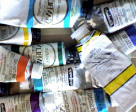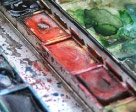Oil & Acrylic
 Two of the most common mediums used in painting are oils and acrylics. Both have unique qualities and varying benefits or detractions depending on which artist you speak with.
Two of the most common mediums used in painting are oils and acrylics. Both have unique qualities and varying benefits or detractions depending on which artist you speak with.
A few important differences between acrylic and oil paints are how quickly they tend to dry and the options the artist has in how they manipulate the substance to get an intended effect. Acrylic paint offers the artist very quick drying time and depending on how much water is applied, it can take produce an effect more closely resembling an oil, or conversely a water color effect. In short, acrylic can be versatile and efficient.
Oil on the other hand offers the artist a considerable “open time”, or in other words a lengthened time to cure allowing the artist to adjust and alter a work in a more measured manner. Because of its unique chemical make-up, oil paint tends to blend with neighboring colors in way that acrylic does not, offering the artist more control over their colors.
Acrylics are water-based polymers and oil paints are well, oil-based. Both harden when dry.
As a buyer of art, understanding some of the ways each of these mediums acts on a surface, such as canvas, will give you a good idea of how texture, light, or an artist’s technique can impact a finished work of art.
Some More Information on Acrylics and Oils:
- Oil paints naturally tend to be thicker than acrylics and some oil paintings may tend to appear more textured than an acrylic painting. It is possible however to achieve the same effect by mixing acrylic paints with other substances (even gel or molding paste) to achieve “thick” looking paint.
- Oil paints tend to have deeper pigment (or color) than acrylics. This is because the oil base is actually able to absorb more pigment (color) than an acrylic paint. When you are looking at paintings and their colors, take a look at what type of paint was used, you will start to notice the difference between acrylics and oils.
- Acrylic paints can be thinned with water and can be used to produce a wide range of effects. They can be used as “washes” similarly to how a watercolor might look. Additionally, acrylic paints might be a preferred option for mixed media artwork as they can be drawn or painted on once they dry with materials such as charcoal or chalk.
- As mentioned above, oils tend to be thicker as well so they are a good choice if the artist is trying to produce thick and unique textures. In fact, some artists use oil paints with a knife to apply the paint to achieve a unique texture.
Gouache
 Gouache (pronounced “gwahsh”) is a type of paint that shares some similarities with watercolor but also some important differences that make it a good choice for some artists.
Gouache (pronounced “gwahsh”) is a type of paint that shares some similarities with watercolor but also some important differences that make it a good choice for some artists.
Essentially, it is a heavier, opaque (non-transparent) watercolor paint. Because it is opaque the colors on a finished work tend to be deeper and stronger than on a watercolor. Additionally, gouache will appear less “wet” because of the paint properties.
Like watercolor, it is a “thin” paint and the resulting piece is typically very smooth looking.
Watercolor
 Watercolor basically consists of pigment in water, a binding agent that helps the pigment affix to a surface, and a solvent which is in this case, water. Unlike gouache, watercolor is transparent which provides the ability to produce some unique styles.
Watercolor basically consists of pigment in water, a binding agent that helps the pigment affix to a surface, and a solvent which is in this case, water. Unlike gouache, watercolor is transparent which provides the ability to produce some unique styles.
Watercolor’s reputation among artists is that of being somewhat difficult. A closer look at this reputation would show that it is the application of a watercolor to a surface such as paper that adds a dimension to the process that is truly specific to watercolor.
In effect, the surface and watercolor (as long as they are wet) are in a constant dance, or state of change. This dance, as we will call it, is mainly due to the level of absorption of the surface, and the viscosity. These factors, or how “wet” the watercolor is when it is applied, pose a unique challenge to the artist in managing the process.
Watercolor paintings can be extremely detailed, or appear loose and washy. Depending on the artist’s technique and subject matter, watercolor paintings can be extremely detailed or appear loose, playful and washy.


